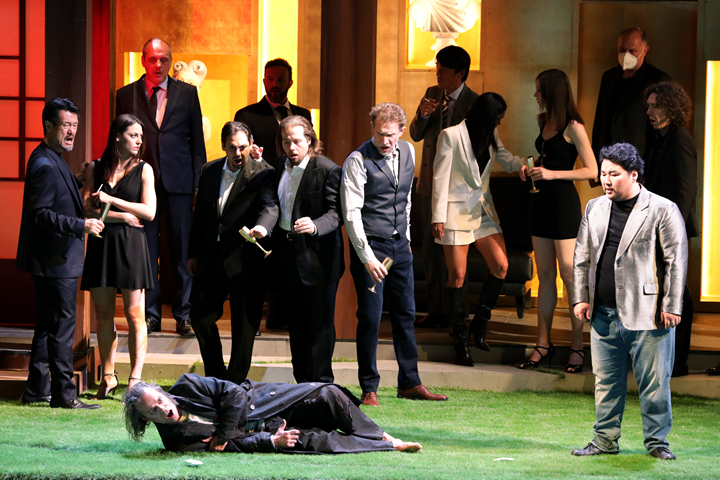| Opera Reviews | 2 June 2024 |
Rigoletto meets Parasiteby Silvia Luraghi |
|
Verdi: Rigoletto |
|

Fabrizio Beggi (Monterone), Amartuvshin Enkhbat (Rigoletto), Ensemble
|
|
|
A new production of Giuseppe Verdi’s Rigoletto directed by Mario Martone raised mixed reactions from a sharply divided audience at La Scala: most people either loved it or hated it. The director said in an interview that he wanted to focus on social unbalance between the rich and the poor and that to do so he took inspiration from award winning Bong Joon-ho’s movie Parasite. The wealthy, the Duke and his friends, and the poor, Rigoletto with his daughter, live in close connection: the sets, designed by Margherita Palli, feature a revolving platform, with the house of the Duke on one side, the house of Rigoletto and Sparafucile’s inn on the other, directly communicating through a door on top of the stairs. The curtain rises on the Duke’s palace, where the Duke and his friends, in modern clothes (by costume designer Ursula Patzak), sniff cocaine amid jokes and sex. When Monterone crosses the room and curses Rigoletto, the sets start rotating and slightly move to the street, where Rigoletto meets Sparafucile, and then lead the audience to Rigoletto’s house. Here a rebellious Gilda meets her lover, then confronts her father pleading for her freedom. In the last act, while Rigoletto is celebrating what he thinks is his victory, the Duke leaves Maddalena’s bedroom singing and enters his palace directly from the door that connects it to the dwelling of the poor. When Rigoletto realizes that his daughter has been killed and remembers Monterone’s curse, the platform turns to show the poor taking revenge and stabbing the rich. Especially in the finale, the director’s view was not immediately clear for an audience who had not read his interview and in my opinion was the weakest part of a production which, on the other hand, had many merits. The director worked extensively with the singers to refine their interpretation with largely compelling results. He was supported by a cast of high vocal quality. In the title role, baritone Amartuvshin Enkhbat proved once again one of the best Verdi baritones of his generation and beyond. The singer can easily modulate his handsomely colored, imposing voice to portray the inner contradictions of a complex character such as Rigoletto. At his side, soprano Nadine Sierra was a defiant Gilda, who could stand up to her father until the end. Her agile soprano mastered the coloratura in the second act, but was also the more dramatic part in the third act. Tenor Piero Pretti was the Duke. He had a slightly difficult start but recovered during the performance and ended with an impressive ‘La donna è mobile’ in the third act. Unfortunately his theatrical interpretation was generic, as he lacked sensuality, and did not give a compelling representation of a voluptuous rascal as the Duke should be. I especially liked bass Gianluca Buratto, a very professional Sparafucile, with an interesting voice that deserves to be heard in more challenging roles. As his sister Maddalena mezzo Marina Viotti also proved both vocally and theatrically compelling as did all singers in other side roles. In the pit, conductor Michele Gamba conducted with an odd choice of tempi, especially in the first act, sounding somewhat slapdash. At opening night the performance encountered a mixed reaction, with boos to the production team and partly to the conductor. I saw one of the last performances, where the audience reaction concentrated on the singers, who received applause and cheers, with an ovation for Enkhbat.
|
|
| Text ©
Silvia Luraghi Photo Brescia e Amisano © Teatro alla Scala |
|







